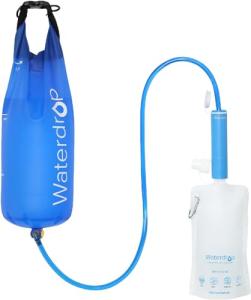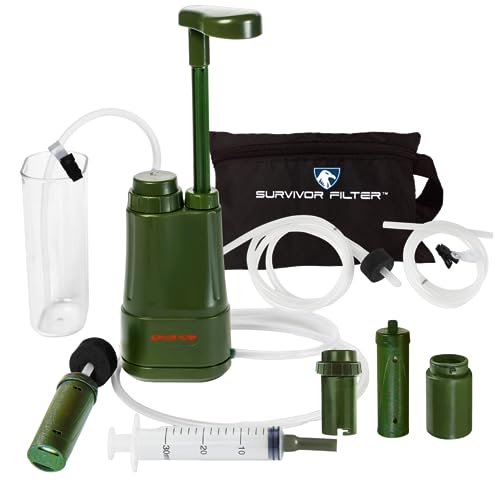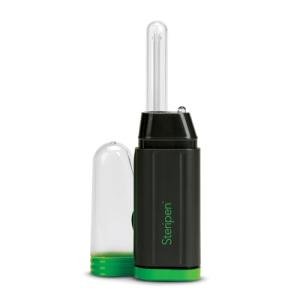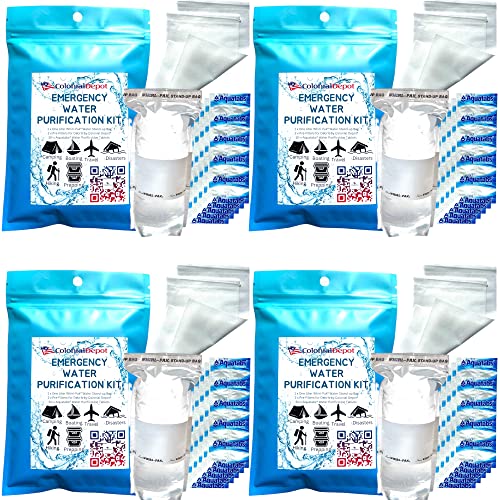In emergencies, clean water can be as precious as gold. Dirty water is full of germs that can make you sick. Our guide shows how to turn risky water safe in tough times. Keep reading; it's easier than you think!
Also check out our Article Essential Survival Gear For Beginners: Picking The Right Gear For Surviving In The Outdoors
Key Takeaways
- Dirty water has germs that can cause sickness. Filters remove these bad things and make water safe.
- There are many kinds of filters like straw, gravity, pump, and UV. Each works differently to clean water.
- Always follow filter instructions for the best results. Replace filters when needed to keep water safe.
- Have a backup way to purify water if your main filter breaks or doesn't work right.
- You can make your own filter with pebbles, sand, cloth, and charcoal in an emergency.
Importance of Water Filtration in Emergencies
In emergency situations, access to clean and safe drinking water is crucial for survival. Contaminated water can pose serious health risks, making water filtration essential for removing harmful contaminants and bacteria.
Common contaminants found in water
Water can carry germs that make you sick. These include bacteria, viruses, and parasites. Dirt, chemicals, and poop may also pollute water. Heavy metals like lead or mercury can be dangerous too.
They get into the water from old pipes or pollution.
Filters help to clean this dirty water. They take out the bad stuff so it's safe for drinking. In an emergency, knowing how to purify your water is a life-saving skill. Always use a good filter to lower the risk of sickness from contaminated sources.
Health risks of consuming contaminated water
Contaminated water can contain harmful bacteria, viruses, and parasites that cause serious illnesses. Drinking contaminated water can lead to gastrointestinal issues such as diarrhea, vomiting, and stomach cramps.
It can also result in more severe health problems like cholera and typhoid fever. These health risks highlight the critical importance of purifying water before consumption in emergency situations or while out in the wild.
The presence of contaminants like pesticides, heavy metals, and toxins in contaminated water poses a grave danger to human health. Exposure to these substances through drinking contaminated water can lead to long-term health complications including damage to the nervous system, liver, and kidneys.
Hence, understanding methods for emergency water purification is vital for safeguarding against these health risks during unexpected scenarios when safe drinking water may not be readily available.
Types of Water Filters for Survival
From personal straw filters to UV purifiers, there are various types of water filters designed for survival situations. Each type has its own advantages and considerations, so it's important to understand the differences in order to choose the best option for your needs.
Personal straw filters
Personal straw filters are portable and lightweight devices designed for individual use in emergency situations or outdoor activities. These filters are effective in removing bacteria, protozoa, and sediments from water sources, providing a convenient way to access safe drinking water on the go.
By using activated carbon and other filtering materials, personal straw filters can improve water taste while reducing unpleasant odors, making them an essential tool for wilderness water filtration.
With their compact size and easy operation, these filters are a practical choice for hikers, campers, and preppers seeking reliable water purification methods.
Personal straw filters are an indispensable item in any survival kit or bug-out bag due to their simplicity of use and ability to provide immediate access to clean drinking water. These filters offer a quick solution for purifying contaminated water without the need for additional equipment or chemical treatments in emergency situations or when venturing into the outdoors.
LifeStraw Camping Water Filter
Stay Hydrated and Prepared on Your Outdoor Adventures with LifeStraw Water Filter
Product information
$24.46
Product Review Score
4.77 out of 5 stars
90 reviewsProduct links
Gravity filters
Gravity filters are a type of survival water filter used for purifying water in emergency situations. They work by using the force of gravity to push water through a filtration system, removing impurities and contaminants.
These filters are effective at removing bacteria, protozoa, and other harmful particles from untreated water sources, providing safe drinking water for outdoor activities and emergencies.
Gravity filters are an essential tool for ensuring access to clean drinking water when traditional sources are unavailable.
Waterdrop Gravity Filter Straw: Survival-Grade Water Purifier
Waterdrop Gravity Filter Straw: The Ultimate Water Purifier for Emergency Preparedness
Product information
$42.99 $39.99
Product Review Score
4.35 out of 5 stars
136 reviewsProduct links
Pump filters
Pump filters are effective for removing bacteria, protozoa, and other harmful contaminants from water in survival situations. These portable filters work by forcing water through a filtration system using a hand pump, providing a reliable source of clean drinking water.
The process is quick and efficient, making it ideal for outdoor adventures or emergencies where safe water sources may be scarce. With their compact size and ease of use, pump filters are an essential tool for anyone seeking to purify water on the go.
Understanding the importance of having access to safe drinking water during emergencies is crucial. Pump filters can easily address this need by providing a practical and dependable solution for obtaining clean water in challenging environments.
Survivor Filter PRO Hydration Extender Series with Replacement Filters
Stay hydrated in extreme conditions with the Survivor Filter PRO Hydration Extender Series and its reliable replacement filters
Product information
$99.95
Product Review Score
4.14 out of 5 stars
80 reviewsProduct links
UV purifiers
UV purifiers are essential for survival water filtration as they use ultraviolet light to kill bacteria, viruses, and other microorganisms in the water. This method effectively disinfects water without the need for chemicals or boiling, providing a quick and efficient way to make water safe for drinking.
UV purifiers are especially useful in emergency situations where clean drinking water is crucial, offering a reliable solution for purifying water in the wild or during natural disasters.
Combining UV purification with other filtration methods can further enhance the safety of drinking water by eliminating harmful contaminants.
SteriPen Adventurer Opti: UV Water Purifier for Preppers
Get clean and safe drinking water wherever you go with the SteriPen Adventurer Opti, the ultimate UV water purifier for preppers
Product information
$111.11 $100.00
Product Review Score
4.57 out of 5 stars
105 reviewsProduct links
Chemical treatments
Chemical treatments are a quick and effective way to purify water in an emergency. Using chlorine dioxide or iodine tablets can kill harmful bacteria, viruses, and parasites present in natural water sources.
These treatments are lightweight and easy to carry, making them ideal for outdoor activities where clean drinking water may be scarce. The process often involves adding the chemical to the water and allowing it time to disinfect before consumption.
When considering chemical treatments for purifying water in emergencies, it's essential to follow the instructions carefully to ensure effectiveness. Factors such as water temperature and turbidity can affect the treatment's efficiency, so understanding how these variables impact the purification process is crucial for safe drinking water.
Disaster-Ready: 200 Aquatabs + Whirl-Pak Bags + Prefilters
Be prepared for any disaster with this comprehensive package of 200 Aquatabs, Whirl-Pak Bags, and Prefilters
Product information
$49.95
Product Review Score
4.16 out of 5 stars
136 reviewsProduct links
Tips for Choosing and Using a Survival Water Filter
Consider the source of water and choose a filter that can effectively remove the contaminants present. Always follow the manufacturer's instructions carefully, have a backup plan in case of filter failure, and maintain and replace filters regularly for optimal performance.
Consider the source of the water
To ensure safe drinking water, it's crucial to consider the source of the water. Whether from a stream, lake, or collected rainwater, potential contaminants like bacteria and parasites could be present.
Look out for murky or discolored water as it may contain harmful impurities affecting your health.
Check if there are any industrial sites or agriculture nearby which might introduce chemicals into the water. Understanding the source helps in choosing appropriate filtration methods and ensures effective purification, making the water safe for consumption in emergency situations.
Follow instructions carefully
When using a survival water filter, carefully follow the instructions provided to ensure proper and effective filtration of water. This is essential for maintaining the functionality of the filter and guaranteeing safe drinking water in emergency situations.
Incorrect use can lead to inadequate purification, putting your health at risk.
Properly maintaining and replacing filters according to the manufacturer's guidelines is crucial for continued efficient filtration. Neglecting this may result in compromised water quality, defeating the purpose of having a survival water filter.
Always have a backup plan
In survival situations, always have a backup plan for purifying water. It is crucial to be prepared with alternative methods in case your primary filtration system fails. This can include carrying purification tablets or knowing how to build a makeshift filter using natural materials like pebbles, sand, and charcoal if necessary.
Being ready with a backup solution ensures access to clean drinking water when traditional methods are not available.
It's essential to always have a backup plan for purifying water in emergencies. Planning ahead by carrying extra purification tools or knowing DIY filtration techniques can make the difference between having safe drinking water and being at risk of consuming contaminated water.
Properly maintain and replace filters
To ensure the effectiveness of your survival water filter:
- Clean the filter regularly to prevent clogging and build - up of contaminants.
- Inspect the filter for any damage or wear and tear, and replace parts as needed.
- Store filters in a cool, dry place to maintain their integrity and functionality.
- Follow the manufacturer's guidelines for replacing filter cartridges or components.
- Test the filter periodically to verify its performance and make adjustments as necessary.
- Keep spare filters on hand for quick replacement during emergencies.
How to Make a DIY Survival Water Filter
Learn how to create your own survival water filter using basic materials and step-by-step instructions, ensuring access to clean drinking water in emergency situations. Keep reading for essential tips and techniques for filtering and purifying water in survival scenarios.
Materials needed
Pebbles, sand, cloth, and charcoal are essential materials for making a DIY survival water filter. These simple items can help remove impurities and bacteria from water in emergency situations.
Additionally, UV purifiers and chemical treatments can be handy tools to have on hand when clean water is scarce.
As you gather the necessary materials for your survival water filter, keep in mind the importance of having a backup plan. Safe drinking water is crucial for survival in emergencies; therefore, being prepared with multiple filtration methods is key to ensuring access to clean drinking water.
Step-by-step instructions
To create a DIY survival water filter, you will need pebbles, sand, cloth, and charcoal.
- Begin by rinsing a plastic bottle thoroughly to remove any residue.
- Cut off the bottom of the bottle to create a funnel for your filter.
- Layer the bottom with a cloth or bandana to prevent the sand from falling through.
- Add a layer of activated charcoal to help remove impurities and odors from the water.
- Follow this with a layer of sand to filter out smaller particles.
- Finally, add a layer of small pebbles or gravel for additional filtration.
- Once all layers are added, pour water slowly through the top of the bottle and collect it at the bottom.
- Allow time for the water to pass through each layer and into your collection container below.
Tips for improving effectiveness
To enhance the effectiveness of your DIY survival water filter, consider using activated charcoal to help remove impurities and odors. Additionally, incorporating layers of fine sand and gravel can help improve filtration by trapping smaller particles.
Remember to secure the materials tightly in the container and create a steady flow for better results. Regularly monitor the condition of your filter to ensure it continues to function optimally, as clean water is crucial for survival in emergencies.
For greater effectiveness when using UV purifiers or chemical treatments, follow the manufacturer's instructions precisely and allow sufficient contact time for purification. Remember that clear water allows these methods to work more efficiently, helping you obtain safe drinking water during unexpected situations.
Conclusion
In conclusion, mastering survival water filtration is crucial for emergency preparedness. Understanding the types of filters and DIY techniques empowers individuals to secure safe drinking water in any situation.
By learning these essential skills, one can confidently navigate unexpected emergencies with confidence and resourcefulness. Whether in the wild or facing a crisis, having the knowledge of water purification provides a vital advantage for surviving and thriving.
FAQs
1. What is survival water filtration?
Survival water filtration is cleaning dirty water using techniques and methods to make it safe for drinking, especially in emergency situations.
2. Can I make a DIY water filter for an emergency?
Yes, you can create a homemade water filter with basic materials to purify water when you need clean water solutions outdoors or in emergencies.
3. What are some natural methods to disinfect my drinking water?
Boiling, using sunlight, or adding certain chemicals are all natural water purification methods that help kill germs and provide safe drinking water.
4. How do I know if the outdoor filtered water is now safe to drink?
After using survival water purification techniques like filtering through cloth or sand and boiling the collected liquid, check that it looks clear and has no bad smell before drinking.
5. Why do beginners need essential tips for emergency water filtration?
Beginners must learn essential skills because knowing how to get clean, potable from nature can save their lives in survival situations where regular options aren't available.





